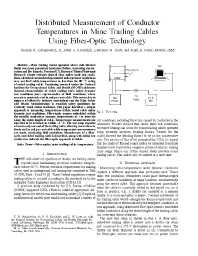Mining Publication: Distributed Measurement of Conductor Temperatures in Mine Trailing Cables Using Fiber-Optic Technology
Original creation date: March 1998
Mine trailing cables operated above safe thermal limits can cause premature insulation failure, increasing electrocution and fire hazards. Previous U.S. Bureau of Mines Pittsburgh Research Center research showed that, under static test conditions, electrical current levels permitted under present regulations may not limit cable temperatures to less than the 90 degree C rating of reeled trailing cable. Continuing research under the National Institute for Occupational Safety and Health (NIOSH) addresses thermal characteristics of reeled trailing cable under dynamic test conditions more representative of field conditions, where operators constantly reel in and pay out cable. This research is in support of efforts by industry associations and the Mine Safety and Health Administration to establish safety guidelines for cyclically rated reeled machines. This paper describes a unique approach to measuring temperatures within reeled cable under dynamic test conditions. Fiber-optic sensors embedded within the metallic conductors measure temperatures at 1-m intervals along the entire length of cable. Temperature measurements are reported to be accurate to within +-1 degree C. The test setup requires access to only one end of the trailing cable, allowing researchers to freely reel in and pay out cable while temperature measurements are made, simulating field conditions. Manufacture of a fiber-optic-embedded trailing cable is described, along with initial test results that indicate the fiber-optic approach is viable.
Authors: TH Dubaniewicz, PG Kovalchik, LW Scott, MA Fuller
Peer Reviewed Journal Article - March 1998
NIOSHTIC2 Number: 20000810
IEEE Trans Ind Appl 1998 Mar 34(2):395-398
See Also
- Derating Factors for Round and Flat Mine Trailing Cables
- Detrimental Effects of Capacitance on High-Resistance-Grounded Mine Distribution Systems
- The Effects of Restricted Workspace on Lumbar Spine Loading
- Investigation of Ampacity Derating Factors for Shuttle Cars Using Fiber Optics Technology
- Lasers
- Overview of Mine Fire Detection
- A Passive Means to Detect Hot Trolley Insulators
- Solutions to Prevent Materials-Handling Injuries in Underground Coal Mines
- Technology News 474 - A Passive Means to Detect Hot Trolley Insulators
- Thermal Modeling of Portable Power Cables
- Use of Infrared Sensors for Monitoring Methane in Underground Mines
- Content source: National Institute for Occupational Safety and Health, Mining Program


 ShareCompartir
ShareCompartir
